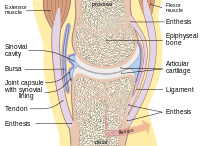
Photo from wikipedia
This study assessed the quality of life (QOL) and the functional outcome in daily living in patients with a chronic, treatment-resistant periprosthetic joint infection (PJI) or osteomyelitis, living with a… Click to show full abstract
This study assessed the quality of life (QOL) and the functional outcome in daily living in patients with a chronic, treatment-resistant periprosthetic joint infection (PJI) or osteomyelitis, living with a natural or iatrogenic sinus tract. Methods: A follow-up examination in three national reference centers for septic bone and joint surgery was performed utilizing the Hospital Anxiety and Depression Scale (HADS-D/A), the Visual Analogue Scale (VAS), and the Short Form-36 (SF-36) score, including patients with a chronic sinus tract due to treatment-resistant PJI or osteomyelitis. Results: In total, 48 patients were included, with a mean follow-up time of 43.1 ± 23.9 months. The mean SF-36 Mental Component Summary (MCS) was 50.2 (±12.3) and the Physical Component Summary (PCS) was 33.9 (±11.3). The mean HADS-D was 6.6 (±4.4) and HADS-A was 6.2 (±4.6), and the VAS was 3.4 (±2.6). The SF-36 MCS showed no significant differences between the study group and the standard population (47.0, p = 0.10), as well as the HADS-A. The PCS in the study population was significantly worse (50.0, p < 0.001), as was the HADS-D. Conclusions: A sinus tract represents a treatment option in selected cases with an acceptable QOL. The treatment should be considered for multimorbid patients with a high perioperative risk or if the bone or soft tissue quality prevents surgery.
Journal Title: Journal of Personalized Medicine
Year Published: 2023
Link to full text (if available)
Share on Social Media: Sign Up to like & get
recommendations!